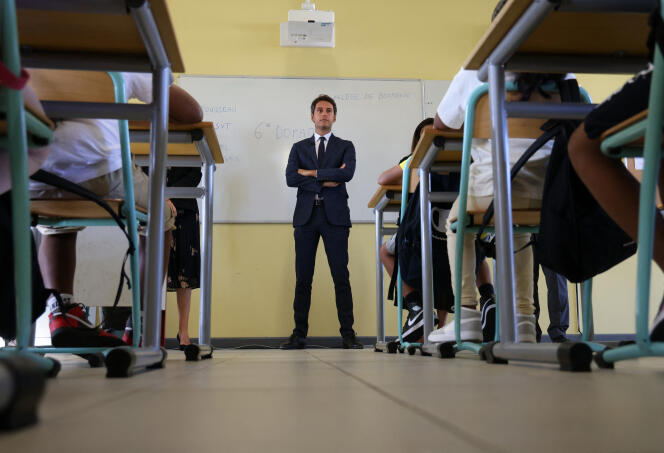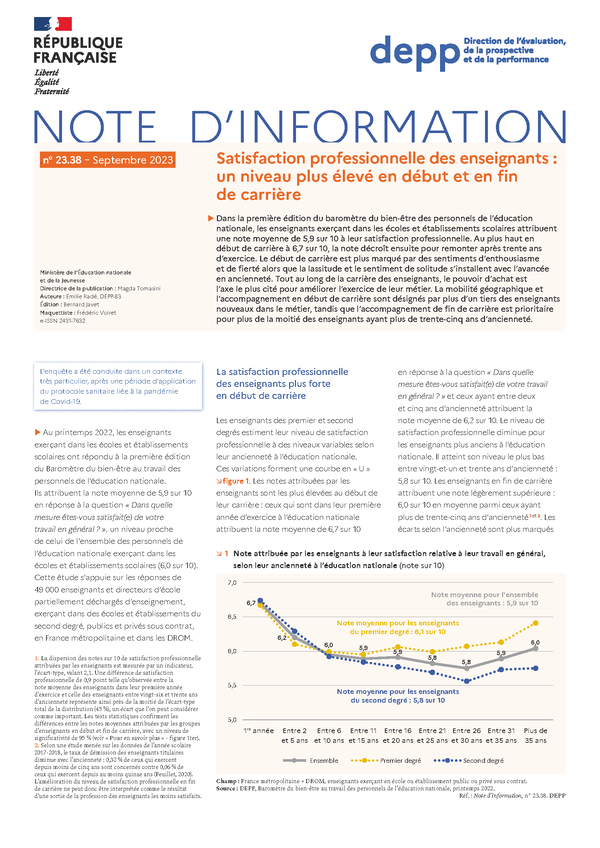The South African actress speaks without a wink about her job and the fantasy of the woman who cannot age.
Charlize Theron is perhaps one of the most interesting actresses of her generation. The one who would have been content to play beautiful blondes rescued by the brave hero preferred to have a varied career between action films and independent dramas. Decisions that led her to the Oscar for Best Actress in 2004 for her role as a murderous prostitute (where she was crowned at the same time as her former companion Sean Penn). “Monster.”
But this little cinematic gem should not remain without a sequel: Charlize then made a film of it “In the Valley of Elah”, “Far from the scorched earth” “The street”or even the thundering one “Crazy Max”. A real visual slap in the face that gave her perhaps her most beautiful role, that of a strong woman for whom Hollywood often leaves little room. What do these films have in common? Subtle interpretations of deep roles that young people in their mid-forties appreciate.
However, attaining this grail is not necessarily easy for physically beautiful people, as she explains in the latest issue of GQ. “Really serious jobs are for people who are physically fit, period.”, She says. “How many roles have been written for the damn 1.80 meter tall, beautiful model in an elegant dress? When the roles with some substance came along, I was in the running, but the pretty candidates were the first to get fired.“Clichés are difficult to avoid, especially when you're one of Dior's main muses… However, the fact that you can combine talent, seriousness and a dream body is proven by the actress, who once again appears statuesque on the cover of the British edition of the magazine.”
Cned introduces free online training on environmental topics for the first time
THE Cned (National Center for Distance Learning) is launching the “BA-BA for Climate and Biodiversity” this Wednesday free online training supported by Radio France, the group to which France Bleu belongs. The aim of this initiative is to democratize knowledge about environmental issues. “Prerequisites for awareness and action” in the face of the climate emergency.
The aim of the training is to give everyone “Key to understanding At “the causes, consequences and solutions to climate change and biodiversity loss”. she was “designed with a committee of public research reference experts”. Two paleoclimatologists and members of the IPCC support this approach: Valérie Masson Delmotte and Jean Jouzel are the sponsors of this platform.
This training is concrete freely available on the Internet. It consists of five modules with duration “between 1 hour and 1 hour 30 minutes each” :
- definition of climate change;
- Causes of climate change and solutions to mitigate it;
- Consequences of climate change and solutions for adaptation;
- Biodiversity;
- collective and individual decisions to achieve carbon neutrality.
Users interested in this training can complete the modules in the order they prefer. Then they can “Confirm your knowledge with a quiz”, and if they perform well, they will be offered a digital badge. If they manage to have all five badges, they can receive them “a 'BA-BA Climate and Biodiversity' badge that certifies the entire training.”
One in four French people suffers from environmental anxiety
To mark the launch of this training, Cned is publishing this Wednesday a study on the knowledge of the French on climate issues and biodiversity. According to this Obéa survey, almost one in four French people (25%) suffer from environmental anxiety “Fear of the future, often thinking about what prevents him from living peacefully or even giving up medium or long-term projects, such as having children”. This feeling is shared by 34% of 15 to 25 year olds and 35% of 26 to 35 year olds. Furthermore, 65% of French people admit this “concerned about the situation”without this preventing them from living peacefully.
If the level of ecological concern among the French is very high, then it is the majority considers the level of knowledge to be too low. 59% of respondents believe that the French people's level of knowledge on ecological issues (climate disruption, pollution, biodiversity) is not up to the environmental challenges. 83% find it particularly difficult to identify the right sources to get reliable information. 74% find “It’s complicated to know what to do to protect the environment.”
The study “The French, knowledge and pedagogy on ecological issues” was carried out by Obéa for the Cned with a sample of 1,027 people representative of the resident population of mainland France aged 15 years and over. This survey was conducted online on May 31 and June 1, 2023.
Becoming an online trainer: books to see things more clearly
Online training courses are very numerous and of very different quality. However, it is a market segment that is constantly evolving and offers significant opportunities for those wishing to establish a new training activity. With the introduction of the Personal Training Account (CPF), there are many customers. Overview of some titles you should read before you start.
Since the health crisis, it seems very easy for any trainer to switch to an online activity. If you have been working in this field for some time, you have indeed been able to learn distance learning techniques. However, there are a very large number of tools that can be used to take advantage of the opportunities in this market.
1- Create and sell online training courses (23 €, 188 pages, Eyrolles, 2020)
Subtitled “The method of positioning, structuring content, achieving recurring sales”, this work by Nathalie Antonio Giraud is a real bible for those who want to enter the emerging but already well-structured online training market.
This book offers practical answers to all the questions you might ask before starting your business. It is appropriate which platform to use, to offer your training at what price and in what format… Whether your project consists of online conferences or videos, everything is taken into account. The author is the founder of Rêv'elle Coaching, an online coaching company that is enjoying some success. With knowledge of web marketing and online training, she has been supporting young entrepreneurs in setting up a business for some time.
Although it is necessary to have a good idea of the competition before starting, this will not be enough. You need to think about your added value and what more you can bring to the market you want to be in. Whether in life coaching, sports training, musical training or language learning, success requires a crossroads between uniqueness, clarity, accessibility, visibility and efficiency.
2- The big training book (49 €, 544 pages, Dunod, 2020)
Michel Barabel (lecturer at Paris Est Créteil) and Olivier Meier (professor at Paris Est Créteil) offer a reference work to better understand the consequences of the vocational training reforms implemented from the 2010s to enable workers to train recognize Personal Training Account (CPF) who are fully involved in their training throughout their professional career.
The third edition of this book sheds important light on the new face of vocational training. The authors examine in particular the contributions of neuroscience, but also cognitive science and educational economics, to improving the content offered to training applicants. This joint work summarizes the training occupations and the prospects of this industry for the coming years.
3- Training technology (€24.22, 304 pages, Dunod, 2017)
Here is a real guide for professionals, whether trainers, consultants or even training managers. This fifth edition of Thierry Ardouin's work takes a look at the new approaches and new tools available to trainers.
In order to keep an overview, it will be a matter of analyzing, designing, implementing and then evaluating the training courses offered. This extremely practice-oriented book combines expert opinions, practical sheets for creating a training plan, but also numerous examples. Regardless of your field, you can find keys to make your training more attractive, but also more effective and informative.
Thierry Ardouin is a professor at CIRNEF (Norman Interdisciplinary Research Center in Education and Training) at the University of Rouen. He is also working on a master's degree in education and training with the topic of “Professionalities and Professionalization”.
Illustration: DepositPhotos – Bloomua
Find out more about this news
Comment j’ai fait 10000$ en quatre heures avec un cours en ligne qui n’existe pas encore

Félix, la véritable vedette de la vidéo qu’on a tourné pour notre campagne de sociofinancement.
Vers 13h, jeudi dernier, je n’avais pas encore eu le temps de réfléchir à quoi que ce soit. Tout ce que j’avais en tête depuis le lancement de la campagne de sociofinancement de Hardbacon à 9h, c’était les innombrables tâches qui devaient être effectuées le plus vite possible. Plusieurs d’entre elles n’avaient pas encore été effectuées, mais comme faire une séance de Facebook Live faisait partie de ma liste de choses à faire, j’ai appuyé sur le bouton «Live» de Facebook sur mon téléphone.
Je savais que nous allions franchir la barre des 10000$ dans les prochaines minutes ou heures, mais je n’avais pas encore eu le temps d’y réfléchir. J’étais en mode automatique. Sur la vidéo, j’annonce que je vais rester en direct jusqu’à ce qu’on atteigne l’objectif de financement de notre campagne de sociofinancement, soit 10 000$. À peine ai-je fini de dire ça, à la seconde 53 de la vidéo, que mon équipe m’apprend qu’on a franchi le fameux cap.
On a ouvert une bouteille de mousseux pour célébrer, mais ça m’a pris du temps à vraiment réaliser ce qui venait de se passer. Il faut dire que je n’avais jamais espéré atteindre mon objectif en quelques heures. J’avais même fait passer la durée de ma campagne de 30 à 40 jours, sur les conseils du pdg d’Ulule, Alexandre Boucherot, qui nous a par ailleurs donné un solide coup de main au niveau de la stratégie.
Malheureusement pour ceux qui prennent mes titres trop littéralement, ce succès, tout inespéré soit-il, est le fruit de bien plus que 4 heures de travail. En fait, on a commencé à préparer cette campagne en novembre 2016. Même si nous étions relativement bien préparés, je doutais de nos chances d’atteindre facilement le cap des 10000$.
Mon raisonnement était le suivant. Les projets qui ont le plus de succès sur Kickstarter et cie sont généralement des gadgets sophistiqués offerts à des prix relativement bas. Les contributeurs ont alors l’impression de faire une bonne affaire et, en plus, ils peuvent prouver au monde qu’ils sont des «utilisateurs précoces» en faisant étalage de gadgets qui ne sont pas encore en vente dans les grandes surfaces.
Quand je me suis penché sur les cours en ligne qui avaient eu recours au sociofinancement, je n’en ai trouvé aucun ayant obtenu plus que les 30000$ qu’avait amassé ce cours australien de développement d’applications mobiles. Et encore là, on parle d’un cours de programmation dont le marché est mondial. Pour ma part, ce que j’avais à vendre était un cours sur l’investissement offert en anglais et en français, mais uniquement destiné au marché canadien. Je me pince encore. Alors que nous allons fort probablement franchir le cap des 20000$ aujourd’hui, force est d’admettre que nous avons dû faire quelques trucs intelligents.
Bâtir une audience
Nous avons commencé à bâtir une audience de gens intéressés à en apprendre plus sur l’investissement cet été, afin de préparer le terrain pour le lancement de notre application mobile de courtage. Grâce à la promesse d’offrir du contenu exclusif dans notre infolettre et à des boîtes d’abonnement dispersées partout sur notre site Web, nous sommes parvenus à amasser 4466 adresses courriel en six mois, essentiellement de manière organique.
Mais bâtir une audience ne se résume pas à accumuler des courriels dans une base de données. Il faut que votre audience sache qui vous êtes, clique sur vos liens et réponde à vos courriels. Sans cela, vous n’avez pas d’audience; vous avez une liste de courriels.
À raison d’environ deux courriels par mois depuis l’été, je pense être parvenu à bâtir un lien de confiance avec l’audience de Hardbacon et, c’est clair que ce lien de confiance a été déterminant dans la réussite de notre campagne. Pour développer ce lien, il faut éviter le piège de n’envoyer des courriels que lorsqu’on a besoin de quelque chose (pouvez-vous répondre à ce sondage?) ou lorsqu’on veut se vanter (tel média parle de nous, yé!). Or, c’est précisément ce que font la majorité des entreprises dans leur infolettre.
Pour ma part, je me suis toujours assuré d’offrir quelque chose, comme des trucs ou un texte explicatif au début de chaque infolettre. Après ce texte d’ouverture, je ne me suis par contre jamais gêné pour demander une faveur à mon audience. En fait, le seul jour où j’ai dérogé de cette règle est jeudi dernier, puisque je me suis limité, dans le courriel que j’ai envoyé ce matin-là, à demander à nos abonnés de contribuer à notre campagne et de la partager. Si j’ai pu me le permettre sans conséquence, c’est parce que j’ai déjà beaucoup donné à nos abonnés.
Outre notre infolettre, nous avons créé une seconde liste de courriels de gens spécifiquement intéressés par Pas un autre cours plate sur l’investissement. Pour ce faire, nous avons lancé une page Web présentant brièvement notre cours avant le congé de Noël, qui a récolté 274 courriels en tout. Nous aurions sans doute dû promouvoir davantage cette page, histoire d’accumuler plus de courriels, mais nos moyens ne nous l’ont pas permis.
Faire participer notre audience
Ça semble évident, mais il arrive souvent qu’une entreprise va bâtir une audience sans interagir avec elle. Et quand je parle d’interagir, ça va beaucoup plus loin que de faire des sondages. Ça veut dire échanger par courriel et au téléphone et ça veut même dire travailler ensemble. Dans notre cas, nous avons même élaboré le plan de cours provisoire cet été en collaborant avec nos abonnés. En effet, dans un de mes courriels, j’ai ni plus ni moins qu’inséré un lien vers un «Google Doc» modifiable par quiconque avait le lien, où se trouvait le plan de notre cours. J’avais alors demandé à nos abonnés de modifier le plan comme ils l’entendaient.
Il n’y a eu aucun abus, mais au contraire, plein de suggestions inspirées. Je me souviens m’être rendu dans le document, quelques heures après l’avoir envoyé, et d’avoir la surprise de me retrouver en compagnie de quelques dizaines d’abonnés anonymes, en train de lire et d’améliorer notre plan de cours. C’est donc un cours qui a été conçu spécifiquement pour les besoins de notre audience et qui sera bâti en collaboration avec elle.
La collaboration ne fait toutefois que commencer, puisque notre campagne sur Ulule nous a permis d’aller chercher pas moins de 254 contributeurs, au moment d’écrire ces lignes. Il va sans dire que ces contributeurs seront non seulement tenus au courant, mais surtout, consultés tout au long du développement des cours, dont le tournage commencera sous peu.
En fait, nous avons déjà consulté nos contributeurs pour déterminer ce qu’on offrirait de plus quand la campagne atteindrait des objectifs tels que 25 000$, 30 000$, voire 50 000$. Ces paliers, qui seront dévoilés demain, ont encore une fois été développés de manière collaborative.
Cette approche collaborative permet de développer le produit que notre audience veut, mais aussi, de faire de nos abonnés/contributeurs des parties prenantes de notre succès. Car Pas un autre cours plate sur l’investissement n’a jamais été le cours de Hardbacon; c’est le cours de nos abonnés. Et c’est grâce à eux que notre campagne a connu un tel succès, bien plus que grâce à nos stratégies de marketing.
Tourner une bonne vidéo
Ils disent qu’une campagne de sociofinancement accompagnée d’une vidéo obtient trois fois plus d’argent qu’une campagne sans vidéo. En fait, avoir une vidéo est essentiel, mais il faut aussi en avoir une que les gens vont être capable de regarder jusqu’au bout. Et en 2017, l’attention moyenne des gens est plutôt courte, alors, c’est plus facile à dire qu’à faire. C’est d’autant plus important qu’une vidéo de sociofinancement doit inclure un appel à contribuer, qui se trouve généralement à la fin.
Pour toutes ces raisons, c’était important pour nous de produire une vidéo dont la durée ne dépassait pas deux minutes, résumant l’essentiel de la proposition de valeur de notre cours… sans pour autant être ennuyante. C’est encore une fois plus facile à dire qu’à faire, surtout pour quelqu’un comme moi, qui a tendance à écrire de longues tartines. Heureusement, j’ai eu la chance de travailler avec Ceilidh Barlow-Cash, la directrice du contenu de Hardbacon, qui trouve toujours le moyen de traduire mes phrases qui ne finissent plus en phrases qui ont du punch.
Ensuite, quand on pensait qu’on avait un bon scénario, on a vite déchanté en rencontrant le réalisateur et caméraman Ian Marcoux, sans qui notre vidéo n’aurait pas eu l’air de grand chose. Il nous a vite aiguillé sur ce qui devrait être montré à la caméra et quels passages de notre scénario aurait l’air monotone dans une vidéo. C’est lui qui a tourné la vidéo, en anglais et en français, sur deux jours de tournage. Eh oui, deux vidéos de deux minutes ont nécessitées deux jours de tournage, notamment parce que l’acteur principal n’était pas un naturel devant la caméra… et que le chat, qui était pour sa part un naturel, n’en faisait qu’à sa tête.
Le chat sur une montagne de dollars a sûrement aidé à la propagation de notre vidéo, mais c’est grâce à l’ensemble de l’oeuvre que la vidéo nous a permis de convaincre plein de gens que notre cours sur l’investissement ne serait pas ennuyant et qu’ils devraient par conséquent le précommander. Pour ceux que ça intéresse, voici la vidéo en question:
Créer un momentum
Tout ce qui précède est primordial, mais la clé de notre succès jeudi dernier est selon moi le travail de préparation qu’on a fait pour créer du momentum le jour du lancement. Premièrement, je n’ai pas manqué une occasion d’aborder la préparation de notre campagne de sociofinancement sur ce blogue et dans notre infolettre. Nous avons également publié des messages de plus en plus fréquents sur les médias sociaux rappelant à notre audience que la date du lancement approchait.
Dans le même esprit, nous avions installé un décompte en jours, heures et secondes sur notre page Web de pré-campagne.
Nous avons aussi donné une raison à notre audience de vouloir précommander notre cours dès le jour du lancement. Nous l’avons fait en offrant une version «lève-tôt» de notre cours à 50$ (plutôt que 60$) destinés aux 100 premiers qui choisiraient cette récompense. Cette récompense «lève-tôt» nous a permis de rappeler aux gens de contribuer à notre campagne dès 9h le jour du lancement. Et de nombreux l’ont fait, si bien que les 100 récompenses «lève-tôt» se sont épuisées en quelques heures à peine jeudi.
Le secret, toutefois, derrière le momentum qu’on a créé jeudi dernier est notre réseau d’ambassadeurs d’une part, et notre campagne sur Nouncy de l’autre. Ces deux initiatives combinées nous ont permis de créer une tempête de partage sur les médias sociaux. Pour certains Montréalais, la campagne de Hardbacon avait en quelque sorte pris le contrôle de leur fil d’actualités sur Facebook.
Commençons par notre réseau d’ambassadeurs. Il s’agit de 35 hommes et femmes influents (oui, je sais, il y a plus d’hommes, mais on travaille là-dessus) qui ont accepté de nous donner un coup de main pour promouvoir la littératie financière au Canada par l’entremise de notre campagne. Vous pouvez voir la liste complète sur notre site Web de pré-lancement. Ils ne sont pas payés pour nous aider. ils le font car ils croient que la promotion de notre cours est une bonne chose. C’est Khadija Jouini, la directrice du marketing de Hardbacon, qui a mis en place de main de maître cette initiative.
Nous avons créé une liste de courriels spécifiquement pour nos ambassadeurs, afin de les tenir au courant de notre stratégie de campagne et, le jour du lancement, nous leur avons donné des liens et des photos pour qu’ils aient des choses à partager. Nous les avons aussi invités au pré-lancement de la campagne, qui a eu lieu dans les bureaux d’Ulule, et où il y avait des chips au bacon et des beignes au bacon au menu.
Outre nos ambassadeurs, nous avons convaincu un paquet de gens de partager notre campagne Ulule jeudi dernier. Il s’agissait d’obtenir le plus grand nombre d’impressions sur les médias sociaux dans un laps de temps le plus court possible. Pour cette stratégie, je ne me suis pas limité à solliciter des influenceurs. J’ai sollicité le plus de gens possibles, qu’ils aient des milliers ou seulement des dizaines d’abonnés, pour les convaincre de partager notre campagne jeudi à 9h.
Sachant que l’oubli est humain, on a beaucoup insisté pour que les gens utilisent Nouncy pour pré-programmer leurs partages sur Facebook, Twitter et Linkedin. Concrètement, Nouncy leur a demandé l’autorisation de publier en leur nom et d’entrer un message de partage, puis tous ces messages ont été publiés en même temps jeudi.
En tout, c’est 138 messages de partages pour une audience potentielle totale de 179063 que nous avons rejoint avec notre page Nouncy francophone, et 19 partages pour une audience de 41435 sur notre page Nouncy anglophone. Et c’est sans compter les influenceurs comme Alexandre Taillefer et Jules Marcoux, qui n’ont pas voulu utiliser Nouncy, mais qui ont accepté de partager notre campagne jeudi.
Bon, maintenant que je vous ai expliqué comment on a fait 10000$ en 4 heures, il me reste à inventer comment on va passer de 20000$ à 50000$ avec notre campagne Ulule. Parce qu’honnêtement, nous étions bien préparés, mais pas à un succès aussi soudain et intense. Et comme il y a 35 millions de Canadiens et qu’un gros pourcentage de ce beau monde ne sait pas c’est quoi un FNB, j’ai l’impression qu’on a sous-estimé la taille du marché pour ce cours.
Principales réalisations:
- Lancement de la campagne de sociofinancement de Hardbacon
Mesures de croissance:
- Revenus: 20040,50$ (total: 24 390.50$, croissance: 461%)
- Nouveaux abonnés à l’infolettre : 435 (total: 4468, croissance: 11%)
- Nouveaux abonnés sur Instagram : 226 (total: 1686, croissance: 13%)
- Nouveaux J’aime sur Facebook : 220 (total: 2838, croissance: 8%)
Pourquoi les groupes de niveau au collège pourraient accroître les inégalités sans élever le niveau général

Gabriel Attal commanded: “strong measures” It will be announced at the beginning of December “level up” students. Among them, the Minister of National Education has raised several times the possibility of grouping students according to their level of mathematics and French. “When there are students of such different levels in the same class (…)you end up dragging everyone down”, he justified on November 8 in the Senate. The mission known as the “requirement of knowledge” launched at the beginning of October to prepare future measures and the results of which await, was therefore engaged.“rate” proposal
The management of heterogeneity, consistent with only one university since its creation in 1977, has been at the core of all reflections on this educational segment for almost fifty years. The idea of responding to this by acting in groups of levels, however, does not get the support of any teaching union, with the exception of Snalc. This minority union has been proposing an organization for more than ten years “modular” from the university from 5estudents, for mathematics and French, would be divided between groups “deepening” and, for students with difficulties, groups “basics”, benefiting from a reduction in the number of employees. The Minister, if he did not specify anything about the organization that could be foreseen in the college, has put the idea as an example on several occasions.
In this way, Gabriel Attal embarks on a borderline of the dangers that research has shown. “Managing heterogeneity by separating students according to level does not work and has harmful consequences: it increases inequality and, as international comparisons show, does not raise the overall level”says Dominique Lafontaine, emeritus professor of educational sciences at the University of Liège.
“Catastrophic Consequences”
The work done in grade classes has established the effect of “stigma” it led to a loss of self-esteem and motivation among students from weaker classes, thus affecting their academic performance. Likewise, in the face of a fragile group, teachers, who agree on the difficulty of managing homogeneous classes with a low level, showed a tendency to adjust the learning objectives downwards.
On the contrary, students who are in a good class gain more self-confidence and emulation, which benefits them, thus widening the gap with those who have the greatest difficulties, who are also the most disadvantaged in social situations. The results for good students, less sensitive to the composition of their class than for fragile ones, are not, however, ambiguous.
You have 63.43% of this article left to read. The rest is reserved for subscribers.
Teachers' job satisfaction: higher levels at the beginning and end of their careers
Information notice No. 23.38, September 2023,
The value is highest at the beginning of a career at 6.7 out of 10 and then increases again after thirty years of practice. Starting a career is more likely to be characterized by feelings of enthusiasm and pride, while with increasing seniority, fatigue and a feeling of loneliness set in.
Over the course of a teacher's career, purchasing power is the most frequently cited means of improving professional practice. Geographic mobility and early-career support are cited by more than a third of new teachers in the profession, while end-of-career support is a priority for more than half of teachers aged over 35.
Author: Émilie Radé, DEPP-B3
To quote the publication:
Radé É., 2023, “Teachers’ job satisfaction: a higher level at the beginning and end of their careers”, Information notice, No. 23.38, DEPP. https://doi.org/10.48464/ni-23-38
Virtual return to the Saint-Jean campus
In light of the pandemic, students and professors at the University of Alberta's Campus Saint-Jean (CSJ) are grappling with a new reality this year: the fact that courses are being delivered entirely online.
The fall session began two days ago, but this year you could almost hear the flies falling on the Saint-Jean campus.

Fall 2020 marks a different start to the year than any other.
Photo: Radio-Canada
The entire course CSJ is offered virtually. In the coming months, teachers will pass on their knowledge to students from home.
It will simultaneously be my classroom, my meeting room and my work office
summarizes Samira ElAtia, professor of education and head of graduate studies at the CSJ.

Samira ElAtia, in her new home office.
Photo: Radio-Canada
Keep in touch
Last Friday, the dean of the campus, Pierre-Yves Mocquais, welcomed the hundred new students via a screen. Another virtual meeting with all students and their families took place on Monday.
Although we will not have students on campus, they will remain closely connected to our community virtually and remotely.
Art student Marie-Laure Verrault is nonetheless worried about the turn her life will take as a young university student.
It's getting harder to make friends now
is afraid of the person whose friends are all students CSJ. When I visit, I still feel a bit like I'm in a community, but much less than before
she admits.
Like Ms. ElAtia, the teachers of CSJ, They spent the summer preparing to resume their classes remotely.
It will be different because about half of my students are still afraid of technology and often benefit from that exposure in the classroom so I can explain things to them and show them how to do it
She explains.
Marie-Laure Verrault trusts her ability to adapt to online courses. Even though a technical problem disrupted his first day of distance learning.
The E-Class website, where you can look at your courses and see what you need to do, had too many students on it at the same time, she said. And then the site was no longer functional and no one could do their work
.

Like the approximately 900 students at the Saint-Jean campus, Marie-Laure Verrault is also learning to adapt to her new university life.
Photo: Radio-Canada
Due to the sudden increase in online activity, the university's system experienced some disruptions, but the issues were quickly resolved
says the dean of the campus, Pierre-Yves Mocquais.
To facilitate communication, Samira ElAtia created online documents that she personalized according to her students.
She didn't hesitate to give them her phone number so they could ask her questions and organize individual help sessions more easily.
During this time of change and uncertainty, she hopes to reduce the stress that may affect her students.
Teachers have to give a lot of themselves to the mental health and psychological well-being of students.
The exceptions that prove the rule
Certain educational experiences that still require in-person instruction will be offered on campus, such as educational internships.
The teacher training students are observing all necessary and recommended health measures and precautions and are therefore completing their internships this year within the framework of the agreements made with the respective school authorities.
stated the dean CSJ.
The immersive stay experience in French is also retained. This will be available at the beginning of the year thanks to special temporary accommodation in the university's International House.
clarified Mr. Mocquais.
All residents will be housed on the same floor to form an exclusively French-speaking cohort supported by staff who also speak Molière's language.
I would like to emphasize that this measure is only temporary in nature and does not in any way represent a permanent relocation of residential services to the North Campus.
guarantees Mr. Mocquais.

Pierre-Yves Mocquais, Dean of the Saint-Jean Campus
Photo: Radio-Canada / Sébastien Tanguay
This year, 24 students have registered at the Saint-Jean residence, which usually receives them. An insufficient number to consider a safe reopening of this student accommodation at the beginning of the 2020/2021 school year, the communications department reported CSJ.
She will reopen its doors as soon as the situation ensures the health safety of residents
assured Mr. Mocquais.
The campus is still taking time to decide whether students will physically return to class during the winter session.
With information from Mirna Djukic.
Why are more and more young men getting rid of their body hair? – UnMec.fr
Today, the world of beauty is not only associated with women. In fact, men are paying more and more attention to their appearance. In an ever-evolving world, we are currently witnessing a real shift in the world of male beauty.
Cosmetic products for men are experiencing remarkable development. There are also hair problems in this area. While these often bother women, men also tend to remove more and more hair. A new study has also found that more and more young men are embracing hairless bodies.
Men have so far been spared from hair problems
Women have long been pressured to remove their body hair, often leading to outrage and disgust when they fail to do so. In 2013, a study showed that 95% of women ages 16 to 24 reported having hair removed from their armpits, while 92% had shaved their legs.
Here is a topic about hair removal for men:
In the past, the topic of body hair has been more women-focused. Meanwhile, new research suggests this is changing as more young British men embrace hairless bodies.
The number of men removing hair is increasing
According to the study, 46% of men had their body hair removed in 2018, compared to 36% in 2016. 57% of men aged 16 to 24 have removed pubic hair, compared to 40% two years ago; 42% remove armpit hair, up from 16% previously.
Chest hair removal has doubled in the last two years and is now at 30%. Although these numbers are still well below the percentage of female body hair removal, they represent a significant increase. This rise in power would be driven by social media.
Here's a look at the surprising amount of time men and women spend on their appearance

A woman worried about her appearance in front of a mirror ©BelgaImage
Did you think that only women really care about their image? So think again! As a large study published in the journal Evolution and Human Behavior shows, concern about one's appearance is a common problem for both genders. Everyone devotes almost four hours to this task, with the difference between men and women being minimal (the fairer sex devotes only 23 minutes more). And it's not the fault of any culture or country! The study, carried out by an international team of scientists and considered one of the largest intercultural studies of all time, included 93,158 nationals from 93 countries. Instead, they noticed other very interesting nuances to learn more about humanity's relationship with beauty.
Worrying about your image, “a universal phenomenon”
On a global level, there are few people who don't care about their appearance. Only 0.003% of respondents said they do nothing to improve their appearance, and 1% believe they devote no more than 10 minutes a day to this task. In both cases, one gender does not appear to be overrepresented compared to the other. “From this we conclude that beauty behavior is a universal phenomenon“, note the researchers.
A phenomenon that doesn't surprise her. Studies had already shown that individuals are more attractive “are often treated more positively, preferred as potential partners and friends, perceived as healthier and more competent, more likely to be hired for jobs and earn tips and higher wages, are more popular with both athletes and politicians, and report higher psychological well-being and lower levels of stress and depression“In short, making yourself look good is serious business!
The strategies of each gender for finding a partner
However, men and women differ in their methods of caring for themselves. For example, the former do more physical exercise than the latter. According to scientists, this is related to the idea “ancestral“that men’s abilities and strength are related to their physical fitness and therefore their greater attractiveness.”Lean muscle mass is also associated with more sexual partners“, they state.
For the fairer sex, the study finds behavior that would be specific to them and is presented in the form of a U-shaped pattern. Young adults, who are more likely to be looking for new partners, spend more time improving their appearance. People in their 40s prefer to pursue other activities. But once you cross the 60-year mark, concerns about hiding the signs of age take over and the amount of time devoted to appearance begins to increase again. Men are lucky: Overall, their image is considered less age-related, which is why this U-shaped pattern cannot be found on them.
Another fascinating point: the importance of marital status. On average, people are looking for new partners”spend more time improving their appearance than single people (an average of 24 minutes more per day), married people (26 minutes more) and people in relationships (29 minutes more)“.”The results challenge previous assumptions about improving appearance as a tactic for retaining existing partners“, emphasize researchers who relativize the importance of sexual competition and social prestige.
The importance of stereotypes
Other findings from this study include the fact that women from countries where gender equality is lower are more concerned about their image. The article even notes that this effect is particularly “important” at the individual level (more so than at the national level). This is because women in these more traditional contexts have to make greater efforts to live up to the stereotypes attached to them. They are then more likely to resort to invasive procedures, especially to increase breast volume.
Even men are not spared the influence of stereotypes. When they feel the influence of a more conservative environment, they may spend more time developing the upper body muscles traditionally associated with masculinity. “A muscular body may be less important for men who do not conform to stereotypical gender roles,” the researchers write.
Overall, people from less egalitarian countries spend almost an hour and a half more improving their attractiveness, whether with men or women, and this number may be even higher when stereotypes are found at the individual level. It also seems that people from more collectivistic countries like South Korea follow beauty regulations more vigorously. Coming from a more individualistic country has less influence on the final result.
Social networks, health status, socioeconomic level, etc.
Researchers note a number of other factors. For example, media presence plays a fundamental role. In fact, it appears that social media use is the most important predictor of an increase in time spent worrying about one's image. Television also has a significant influence. Stress, depressive symptoms, and body dissatisfaction increase when exposed to images of models, photoshopped people, and beauty product advertisements. However, it is also possible that people who are interested in their image are, conversely, more interested in social networks.
People with more severe histories of infectious diseases also spent slightly more time worrying about their physical appearance, particularly for men. This could either be related to their efforts to hide imperfections (e.g. skin condition) or the fact that they take longer than others to prepare (e.g. men can start applying make-up, although more difficult than women) .
The study concludes that men spend more time improving their beauty when their socioeconomic status is higher, while women do so especially when their education level is lower. The same applies to people with right-wing political beliefs (but only among women). Furthermore, socioeconomic status, level of education and political beliefs have very little influence.
how the teacher transfer system collapsed
For sixteen years, Stéphane (those referred to by their first names did not want to give their names) made the same request every year: to be transferred from the academy in Créteil, where he has taught since his time at a vocational high school. At the beginning of his career, he was assigned to the academy in Bordeaux, where he comes from. March, ” Wonder ““The response was positive in the end,” says Sandra, his wife. But the relief was short-lived for this couple with two children. Sandra, a school teacher in Val-de-Marne, had a transfer request she had been making for eight years rejected.
“There was a need in the Gironde, but Val-de-Marne did not approve my departure due to the lack of teachers in the department.”explains the 36-year-old teacher and was then faced with the difficult decision of whether to live 600 kilometers away from her partner, pay for two accommodations and weekly travel, or at least temporarily give up working. ” for what (She has) has completed a five-year course of study and passed a difficult selection test.”.
Like all teachers, the couple knew the rules when it came to holding the competition in public. When expressing desires, teachers do not choose their first practice according to rules that differ between first and second degrees.
At the primary school level, recruitment is academic and winners cannot be assigned only in one of the departments of the academy in which they were admitted, which is not necessarily the one in which they live. For almost three years, between 2018 and 2021, 38-year-old Cécile had to commute between Cherbourg (Manche), the city where she lives, and Flers (Orne), the city where she teaches, because she couldn't managed to obtain a mutation. “I was transferred to Flers for my first job in 2014. At first I only came home on weekends, but after a few years I got fed up and started traveling every day »says the school teacher. Almost four hours drive on Mondays, Tuesdays, Thursdays and Fridays, leaving at 5:30 a.m. and returning at 7:00 p.m.
“Completely ossified” movement
At the secondary level, recruitment is nationwide and those admitted to the competition are deployed across the territory as required in each discipline. Anyone who then wants to change the department in the primary level or the academy in the secondary level must submit to a system based on a points scale (a newly hired teacher has 14), the number of which increases with seniority and depending on the individual and family situation – a possible Disability – or even the type of position held. “A married teacher with children is actually more likely to be transferred than a single teacher.”summarizes the Ministry of National Education.
You still have 75.02% of this article left to read. The rest is reserved for subscribers.










